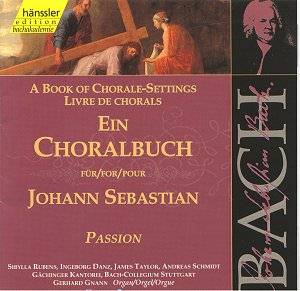Johann Sebastian BACH
A Book of Chorale-Settings: Passion
 Helmuth Rilling Bach-Collegium
Stuttgart Sibylla Rubens, Soprano Ingerborg Danz, Alto James Taylor, Tenor
Andreas Schmidt, Baritone Gerhard Gnann, Organ
Helmuth Rilling Bach-Collegium
Stuttgart Sibylla Rubens, Soprano Ingerborg Danz, Alto James Taylor, Tenor
Andreas Schmidt, Baritone Gerhard Gnann, Organ
 hänssler CD.92.79
[79:16]
hänssler CD.92.79
[79:16]
A Book of Chorale-Settings: Ascension, Pentecost and Trinity
 Helmuth Rilling Bach-Collegium
Stuttgart Sibylla Rubens, Soprano Ingerborg Danz, Alto James Taylor, Tenor
Andreas Schmidt, Baritone Gerhard Gnann, Organ
Helmuth Rilling Bach-Collegium
Stuttgart Sibylla Rubens, Soprano Ingerborg Danz, Alto James Taylor, Tenor
Andreas Schmidt, Baritone Gerhard Gnann, Organ
 hänssler CD 92.080 [78:42]
hänssler CD 92.080 [78:42]

These two discs are part of the hänssler complete Bach edition (numbers
79 &80), recorded by Helmuth Rilling after finishing his series of the
sacred cantatas of JS Bach in 1985. They are actually volumes 2 and 3 of
a sub-series recording the composer's chorale settings, and while both have
a booklet which is near identical, bar the texts, volume 2 presents music
meditating on Christ's Passion - the crucifixion, suffering and redemptive
sacrifice - volume 3 on settings for Easter, Ascension, Pentecost and Trinity.
Both discs are extremely lengthy, offering as much music as is possible to
pack onto a CD, and very similar in character, featuring the same performers
offering a range of Bach's choral song. There are 44 pieces on the Passion
disc (including chorales of the St. Mark Passion), 28 on the Easter, Ascension,
Pentecost and Trinity programme.
Chorales are Protestant hymns, of which, in many different guises from organ
settings, through his cantatas, oratorios, passions and motets, Bach wrote
somewhere in the region of 400. Following the hymnbooks of Bach's time, the
music recorded on these discs is compiled according to its use around the
Protestant church calendar. The notes by Elizabeth Graf explain:
"What we wanted to do was arrange the four-part chorale settings according
to these hymn schedules… The vocal origin of all the hymn arrangements
is uncontested, therefore they are performed in our recording in a way familiar
to us from the cantatas, passions, etc…"
Thus, while around half the pieces may be familiar from longer works, the
remainder are free-standing pieces which are largely unknown; though at least
some almost certainly originated in now lost cantatas and other sacred pieces.
The reason we have these is that Bach's chorales were so popular that even
in the composer's lifetime, they were extensively collected, the first anthology
produced by one of the composer's music students, Johann Ludwig Dietal in
the mid-1730s. The result is a series of albums drawn from music ranging
across Bach's work, arranged by the nature of the text.
Elizabeth Graf says: "So if this is not an audio reference book - could it
be an audio hymn book?" Actually, these albums are both: valuable archive
documents, and living hymn books. From the point of view of a purely musical
experience, of course Bach did not intend anyone to listen to 44, or even
just 28, of his hymns in continuous succession. In fact he did not intend
some of this music for passive listening at all, but for congregational singing.
And that, depending on what use you intend to put these discs, may be a problem.
The singing, playing and recording are all of a high standard, and every
effort has been made to provide variety through the choice of sequencing
and the vibrancy of the performances, yet these are ultimately albums either
to dip into or to use for reference. The very nature of the programmes leads
to inevitable repetition, even in the hands of a composer as divinely inspired
as Bach.
Of course, taken in their original context as worship music, these pieces
should reward those Christians who have ears to hear; the least of Bach being
infinitely more musical and uplifting than the trite MOR that is the low
ebb of current popular Christian music.
Reviewer
Gary. S. Dalkin
Both discs -


![]()